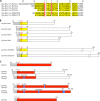Type IV pili in Gram-positive bacteria
- PMID: 24006467
- PMCID: PMC3811610
- DOI: 10.1128/MMBR.00063-12
Type IV pili in Gram-positive bacteria
Abstract
Type IV pili (T4P) are surface-exposed fibers that mediate many functions in bacteria, including locomotion, adherence to host cells, DNA uptake (competence), and protein secretion and that can act as nanowires carrying electric current. T4P are composed of a polymerized protein, pilin, and their assembly apparatuses share protein homologs with type II secretion systems in eubacteria and the flagella of archaea. T4P are found throughout Gram-negative bacterial families and have been studied most extensively in certain model Gram-negative species. Recently, it was discovered that T4P systems are also widespread among Gram-positive species, in particular the clostridia. Since Gram-positive and Gram-negative bacteria have many differences in cell wall architecture and other features, it is remarkable how similar the T4P core proteins are between these organisms, yet there are many key and interesting differences to be found as well. In this review, we compare the two T4P systems and identify and discuss the features they have in common and where they differ to provide a very broad-based view of T4P systems across all eubacterial species.
Figures













References
-
- Pelicic V. 2008. Type IV pili: e pluribus unum? Mol. Microbiol. 68:827–837 - PubMed
-
- Burrows LL. 2012. Prime time for minor subunits of the type II secretion and type IV pilus systems. Mol. Microbiol. 86:765–769 - PubMed
-
- Burrows LL. 2005. Weapons of mass retraction. Mol. Microbiol. 57:878–888 - PubMed
-
- Mattick JS. 2002. Type IV pili and twitching motility. Annu. Rev. Microbiol. 56:289–314 - PubMed
Publication types
MeSH terms
Substances
Grants and funding
LinkOut - more resources
Full Text Sources
Other Literature Sources
Molecular Biology Databases

